Digital Lending Platform Market Size and Forecast 2025 to 2034
The global digital lending platform market size was calculated at USD 10.91 billion in 2024, and is projected to hit around USD 13.8 billion by 2025, and is anticipated to reach around USD 114.72 billion by 2034. The market is expanding at a solid CAGR of 26.53% over the forecast period 2025 to 2034. The North America digital lending platform market size reached USD 3.82 billion in 2024. The benefits offered by digital lending platforms, such as enhanced loan-optimized loan processes, can drive the digital lending platform market growth.
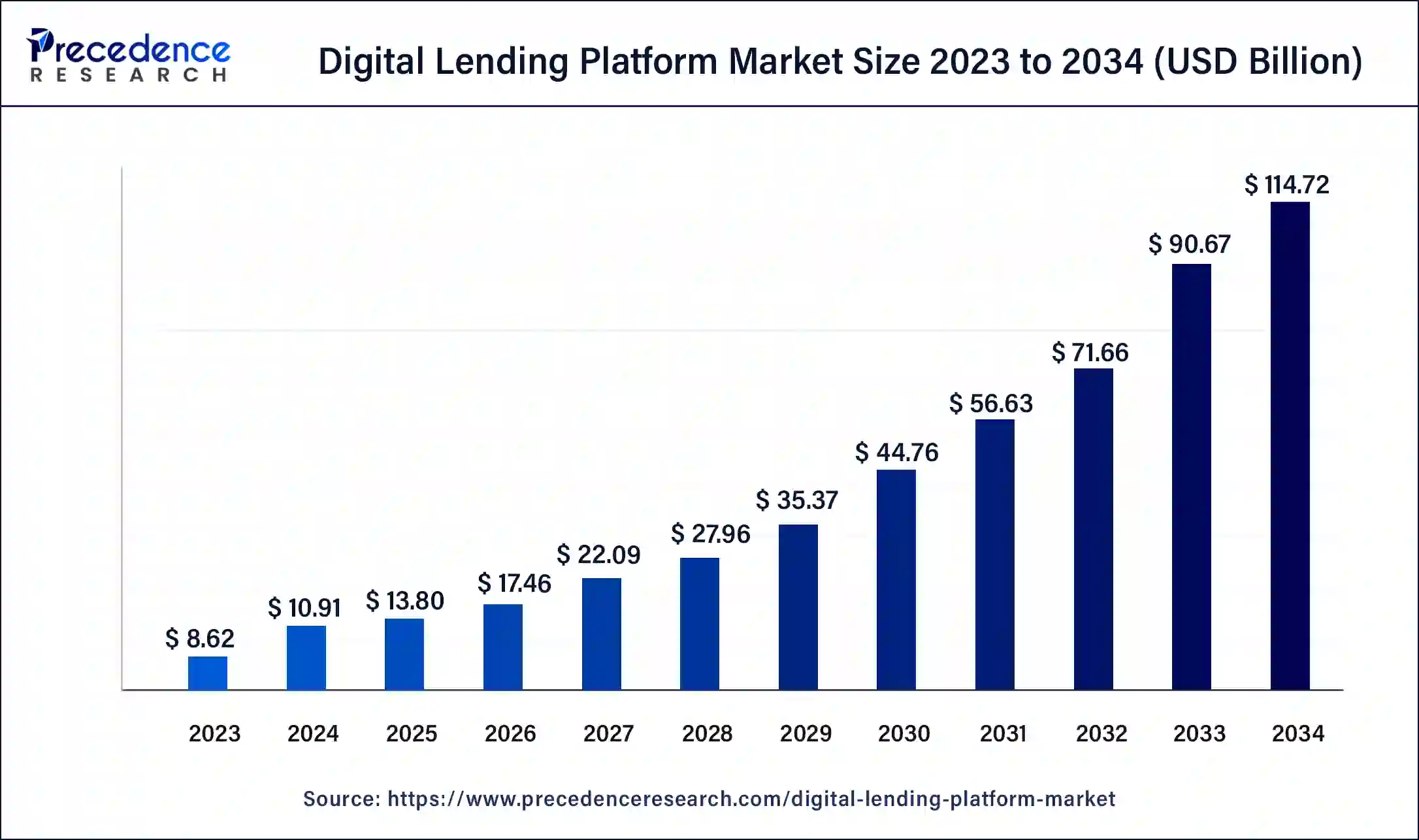
Digital Lending Platform Market Key Takeaways
- In terms of revenue, the digital lending platform market is valued at $13.8 billion in 2025.
- It is projected to reach $114.72 billion by 2034.
- The digital lending platform market is expected to grow at a CAGR of 26.53% from 2025 to 2034.
- North America dominated the digital lending platform market with the largest market share of 35% in 2024.
- Asia Pacific is expected to show the fastest growth in the market through the forecast period.
- By solution, the business process management segment dominated the market in 2024.
- By solution, the lending analytics segment is anticipated to grow at the fastest rate in the market over the forecast period.
- By service, the design & implementation segment led the global market in 2024.
- By service, the consulting segment is projected to witness the fastest growth in the market during the forecast period.
- By deployment, the on-premise segment has contributed more than 70% of market share in 2024.
- By deployment, the cloud segment is expected to expand at the fastest growing rate in the market over the forecast period.
- By end-use, the banks' segment led the global market in 2024.
- By end-use, the credit unions segment is estimated to experience fast growth in the market during the forecast period.
U.S. Digital Lending Platform Market Size and Growth 2025 to 2034
The U.S. digital lending platform market size was exhibited at USD 2.86 billion in 2024 and is projected to be worth around USD 114.72 billion by 2034, poised to grow at a CAGR of 26.53% from 2025 to 2034.
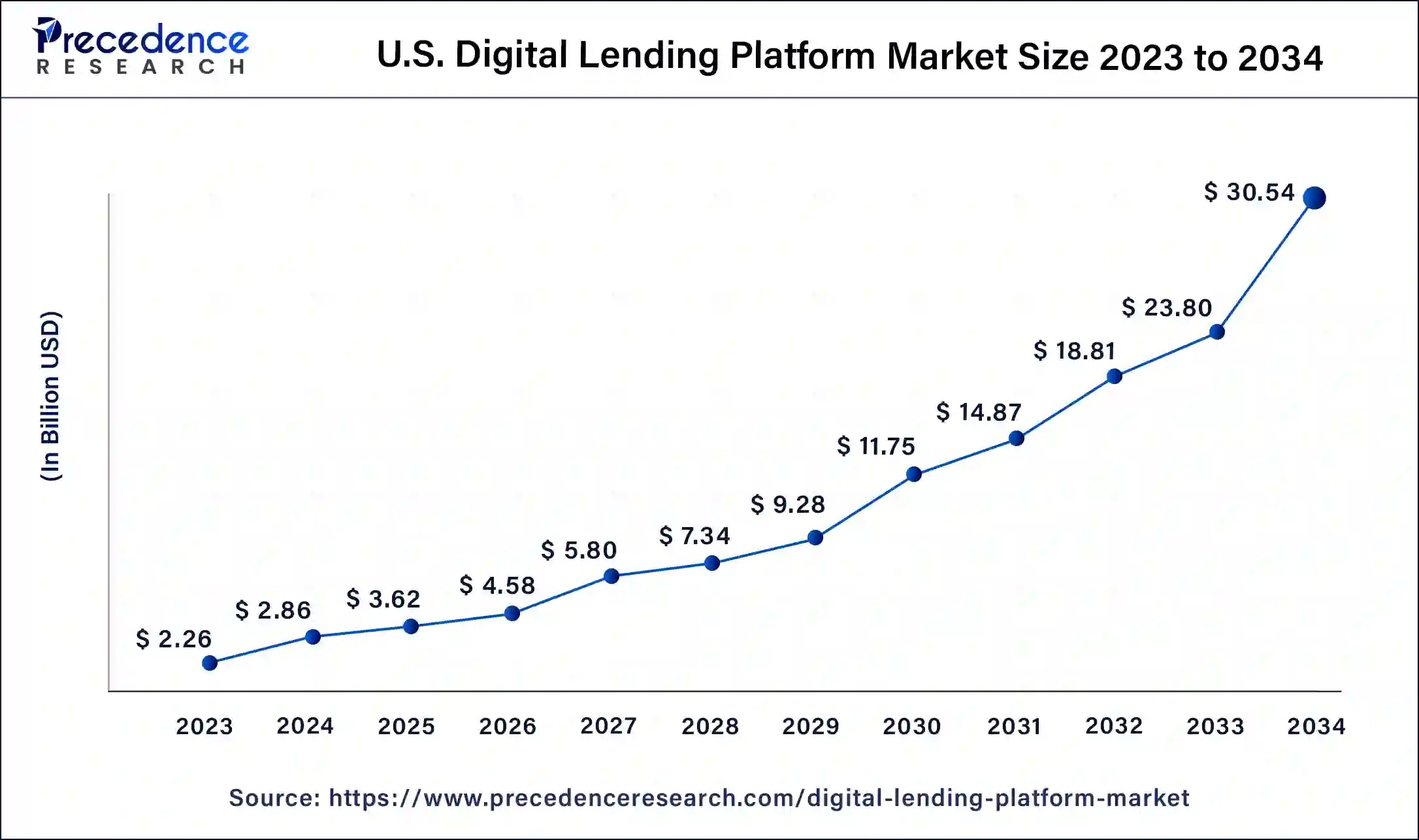
North America dominated the digital lending platform market in 2024. The region has been an early adopter of cutting-edge technologies, leading to a robust demand for digital, end-to-end financial solutions in North America. Moreover, the sizable mobile workforce in the area is prompting financial institutions to digitize their services and enhance customer experience. To gain a significant competitive edge, financial institutions are striving to differentiate themselves by introducing innovative digital services.
- In March 2024, Epic River, a U.S.-based lending-as-a-service platform provider that connects financial institutions with healthcare providers to streamline patient payments, announced the launch of its comprehensive digital lending platform specifically tailored for credit unions.
- In November 2024, Numerated, a leading AI-driven commercial lending platform, announced a strategic partnership with GoDocs, a leader in digital lending documentation, to streamline the commercial loan documentation process for financial institutions. The strategic partnership sets a new standard for faster, smarter, and more efficient commercial lending.
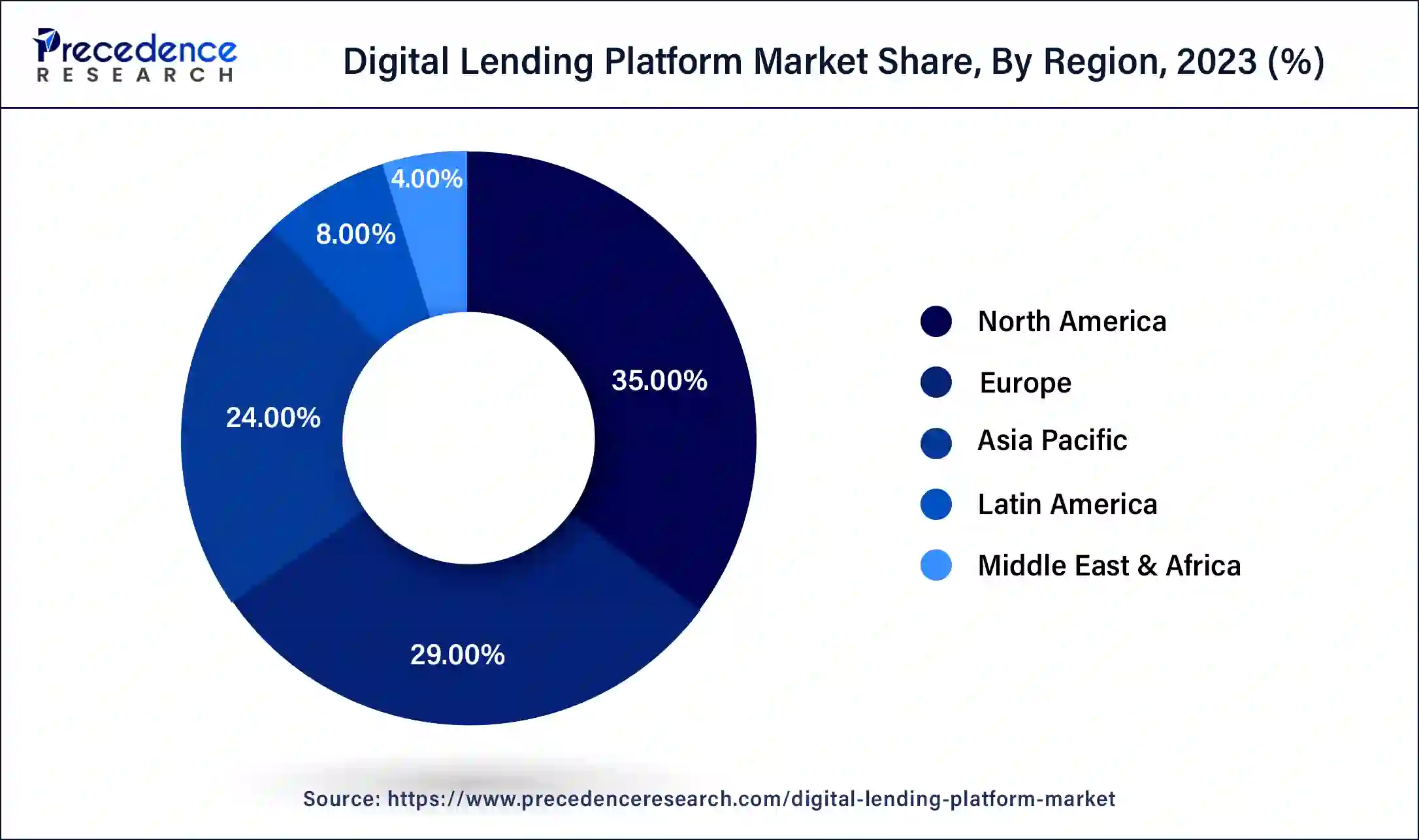
Asia Pacific is expected to show the fastest growth in the digital lending platform market through the forecast period. The region has a substantial population with a notable proportion of individuals who are unbanked or underbanked, driving a significant demand for alternative lending solutions. Digital lending platforms offer accessible and convenient avenues for these individuals to obtain credit. In certain Asian countries, regulatory frameworks have been supportive in fostering innovation and advancing digital financial services.
- China's digital lending platform market is experiencing rapid growth fueled by various factors. The expanding population and increased internet connectivity present a vast market opportunity for digital financial services, including credit providing.
- In January 2025, SBI India's largest bank, launched a digital onboarding process for NRIs to facilitate NRE and NRO account openings, reducing paperwork and turnaround time. This initiative underscores SBI's commitment to leveraging technology for improved customer service. The new platform is an end-to-end digital onboarding process made available across SBI branches in India and select foreign offices.
Market Overview
A digital lending platform offers borrowers a seamless and convenient experience for applying for loans, uploading necessary documents, receiving instant approvals, and managing their loan accounts online. Lenders use these platforms to automate the underwriting process, evaluate credit risk with advanced algorithms and machine learning models, and efficiently handle loan portfolios. Digital Lending Platforms allow consumers to apply for personal loans, auto loans, or credit lines entirely online, significantly reducing the time and effort needed for loan processing. Traditionally a complex and paper-intensive procedure, mortgage lending is now being revolutionized by digital platforms that provide online applications, document uploads, and real-time status updates.
There were 5.64 billion people globally using the internet at the start of April 2025, equivalent to 68.7% of the world's total population. Internet users continue to grow, with the latest data indicating that the total number of internet users around the world grew by 144 million during the past 12 months. The internet user numbers are growing at an annual rate of 2.6% globally, but year-on-year growth is even higher in many developing economies.
Digital Lending Platform Market Growth Factors
- The growing importance of open banking worldwide is expected to drive the digital lending platform market growth during the forecast period.
- Advancements in data analytics and risk assessment techniques can fuel the digital lending platform market growth shortly.
- Rising investments in emerging technologies such as machine learning (ML) and artificial intelligence will likely help in the digital lending platform market expansion.
Digital Lending Platform Market Scope
| Report Coverage | Details |
| Market Size by 2034 | USD 114.72 Billion |
| Market Size in 2025 | USD 13.8 Billion |
| Market Size in 2024 | USD 10.91 Billion |
| Market Growth Rate from 2025 to 2034 | CAGR of 26.53% |
| Largest Market | North America |
| Base Year | 2024 |
| Forecast Period | 2025 to 2034 |
| Segments Covered | Solution, Service, Deployment, End-use, and Regions |
| Regions Covered | North America, Europe, Asia-Pacific, Latin America, and Middle East & Africa |
Market Dynamics
Drivers
Increasing adoption of online banking services
Globalization and the increasing use of online banking services are accelerating the shift toward digitalization in lending processes in the digital lending platform market. This shift is a key factor influencing the adoption of digital lending platforms (DLP) in the banking, financial services, and insurance (BFSI) sector, as these platforms enable better decision-making, improved client experiences, and significant cost savings. Additionally, financial institutions worldwide are swiftly embracing digital channels for lending and managing pandemic-related challenges in response to the coronavirus (COVID-19) outbreak.
- In June 2024, Bandhan Bank launched a new service for the online collection of direct taxes, enabling its customers and others to pay taxes seamlessly across India. As an RBI-appointed agency bank, it also accepts offline payments through its 1,700 branches.
Restraint
Challenges with infrastructure and network connectivity
In the digital lending platform market, outdated telecom infrastructures fall short of providing high-capacity connectivity and low latency, which results in unsatisfactory customer experiences and reduced service quality. Hence, digital lending companies that depend on high-speed internet and online services are expected to face challenges in implementing these solutions. Due to prolonged approval processes, businesses in these regions continue to rely more heavily on offline lending solutions to ensure better understanding and customer satisfaction.
Opportunity
Integration of AI into the banking system can create market opportunities
Many firms are collaborating with traditional banks to bring digital lending solutions to underserved markets. They focus on small businesses by providing specific lending solutions to support their growth. In the digital lending platform market, the advancements in the market include integrating AI-driven credit scoring for quicker loan approvals, partnering with e-commerce platforms to offer instant financing options at checkout, and utilizing blockchain technology to ensure secure and transparent credit transactions. Furthermore, the expansion of the gig economy through small loans to freelancers and gig workers is poised to create opportunities for companies.
- In June 2024, Salesforce India will launch an AI product for digital lending and unveil a dedicated platform for the public sector. The idea behind its new offering of digital lending for loan origination is to consolidate all the relevant information on a single dashboard and help lenders decide if they want to loan out money to a borrower.
Solution Insights
The business process management segment dominated the digital lending platform market in 2024. Business process management has surged in popularity due to its capacity to cut operational costs and significantly increase productivity. The advantages of business process management in lending, such as improved customer satisfaction, increased employee efficiency, minimized errors, and reduced paper usage, are also expected to be the main factors driving market growth.
The lending analytics segment is anticipated to grow at the fastest rate in the digital lending platform market over the forecast period. This is because lending analytics enable lenders to conduct customer segmentation analysis and enhance customer acquisition efforts. Additionally, these analytics aid businesses in achieving faster and more efficient customer onboarding, ultimately improving the customer experience. Many companies providing lending analytics solutions are adopting strategies such as mergers, acquisitions, and strategic partnerships to strengthen their offerings.
- In November 2023, Digital Prime Technologies, an innovative provider of digital asset technology solutions for financial institutions, announced the launch of Tokenet, an institutional digital asset lending platform, which a group of leading firms has already adopted at launch. This groundbreaking platform combines enterprise-grade technology and flexible functionality with industry best practices and expertise expected by traditional financial institutions.
Service Insights
The design & implementation segment led the global digital lending platform market in 2024. The design and implementation segment provides benefits such as operational cost savings and a flexible, agile management approach. Financial institutions need a design and implementation framework to enable the use of digital lending platforms. This framework can also help financial institutions to conduct their lending activities more efficiently.
The consulting segment is projected to witness the fastest growth in the digital lending platform market during the forecast period. Consulting services help digital lending service providers enhance operational speed and efficiency. Many companies consulting for digital lending platform providers concentrate on strategies like partnerships, mergers, and other approaches to bolster their market positions.
Deployment Insights
The on-premise segment dominated the global digital lending platform market. Ongoing costs cover maintenance, upgrades, security measures, and IT personnel needed for system management and support. On-premise platforms give organizations complete control over their records and the ability to decide on system upgrades and transformations. The total cost of ownership (TCO) for on-premise digital lending software includes initial expenses such as implementation, software licenses, hardware infrastructure, and customization.
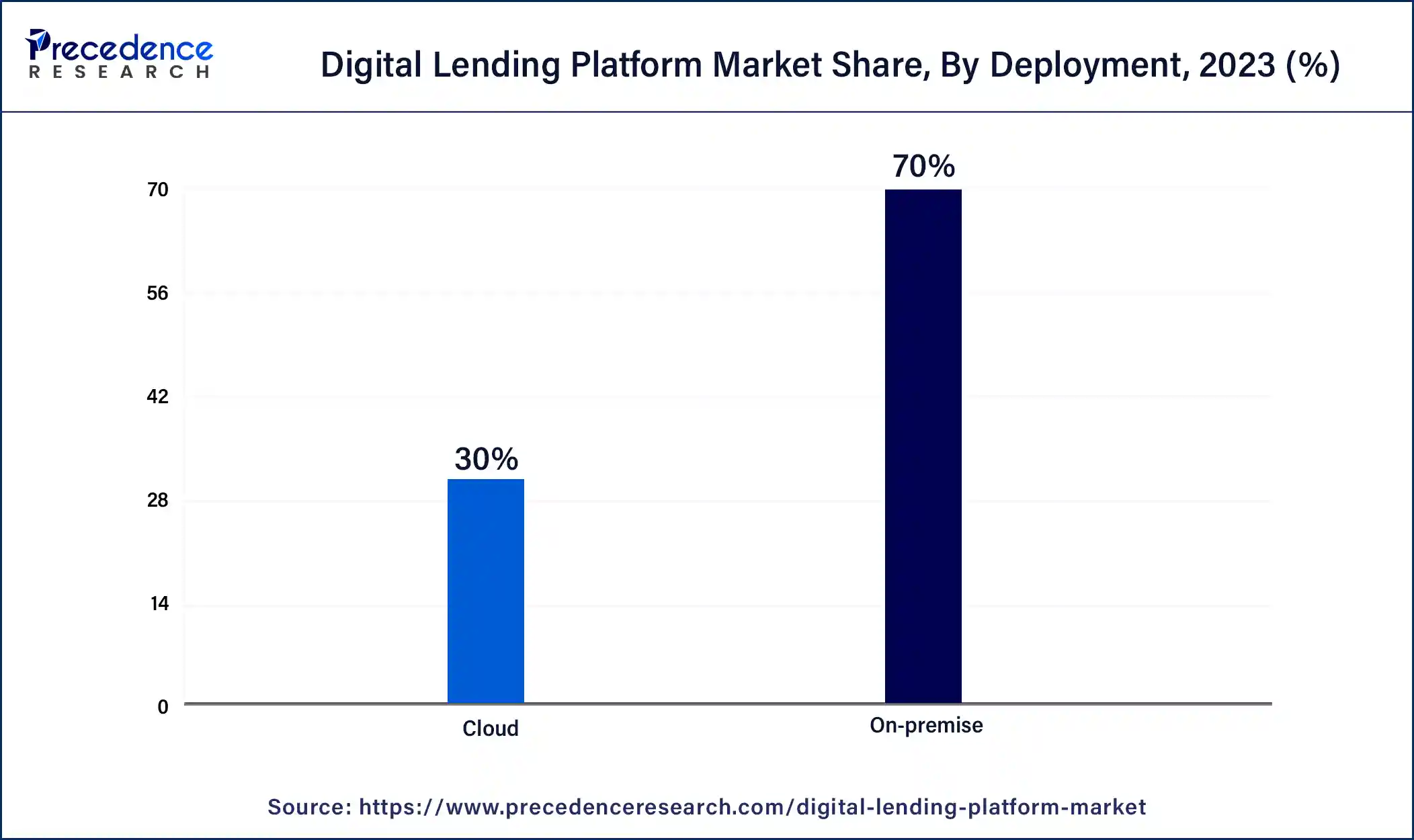
The cloud segment is expected to expand at the fastest growing rate in the digital lending platform market over the forecast period. This can be attributed to the increasing preference for cloud-based platforms among digital lending providers to improve their offerings, which is propelling segment growth. Moreover, Fintech companies are concentrating on implementing cloud-based digital lending platforms and adopting the pay-per-use payment model, which helps to minimize operational costs. This trend is expected to drive the growth of the cloud segment during the forecast period.
End-use Insights
The banks' segment led the global digital lending platform market in 2024. The expected growth of this segment will be fueled by banks' heightened focus on digitalizing their financial services. Additionally, banks often face stricter regulatory requirements, and digital lending platforms can aid in ensuring compliance and automating processes by reducing the risk of errors and non-compliance. Banks have also established long-standing trust and reputation with customers, and by providing digital lending services, they can capitalize on their brand recognition.
- In November 2023, Bendigo Bank launched a new composable lending platform, Bendigo Bank Broker, as part of its ongoing transformation journey. The bank partnered with Seisma and FinXL for the development of the new Bendigo Bank Broker lending platform alongside Infosys for document management. The composable lending platform is said to offer the bank reusable, foundational capabilities across multiple engagement channels.
The credit unions segment is estimated to experience fast growth in the digital lending platform market during the forecast period. The e-signature feature can shorten processing times and improve the customer experience for credit union members. Features such as e-signature and cross-channel support, among others, provide significant benefits to credit unions. Credit unions utilize digital lending platforms to eliminate manual processes and reduce errors, enhancing lending efficiency.
Digital Lending Platform Market Companies
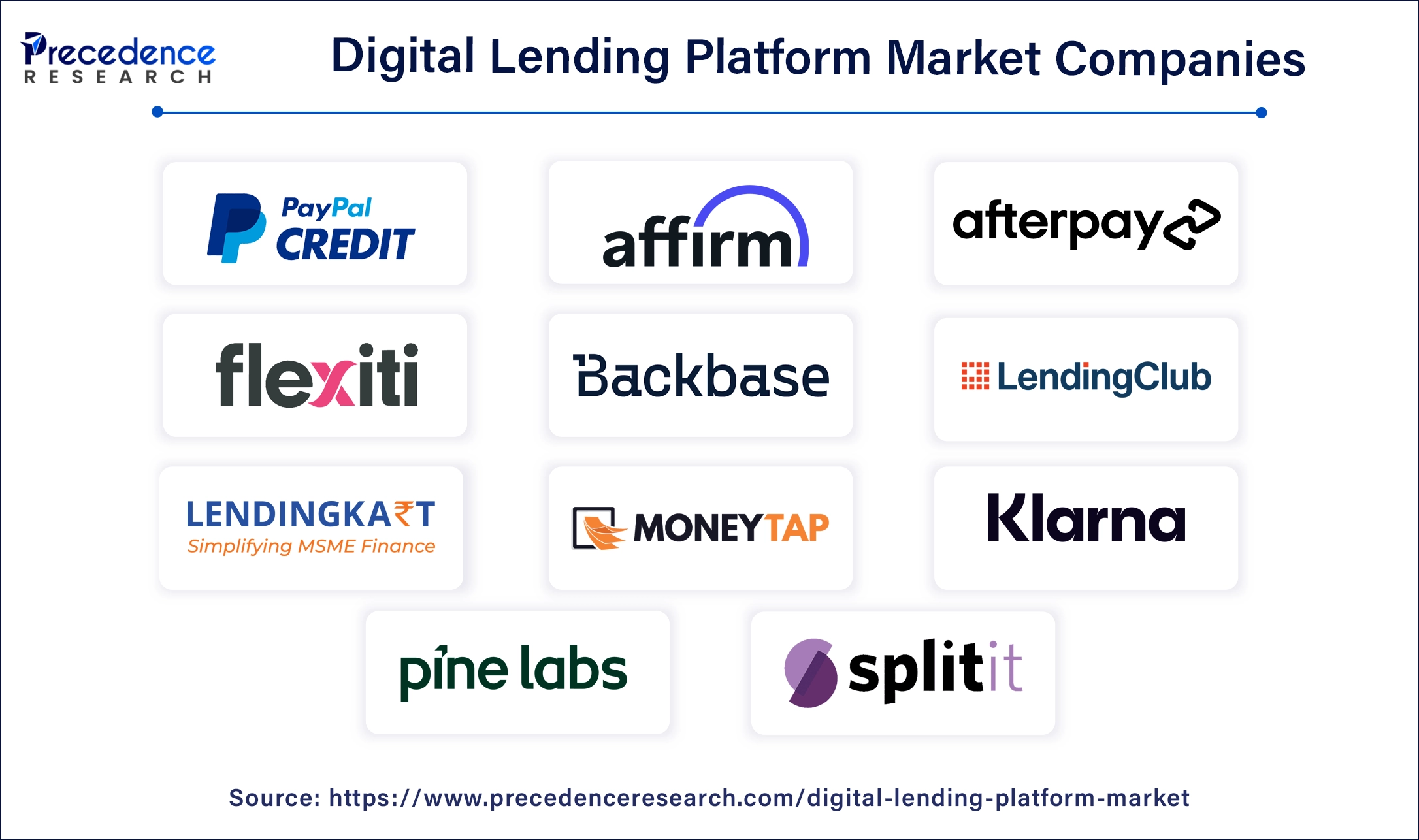
- Affirm
- Klarna
- Lendingkart
- Pine Labs
- Backbase
- MoneyTap
- Afterpay
- LendingClub
- Square Capital
- PayPal Credit
- Splitit
- Flexiti
- Bread
- Upgrade
Recent Developments
- In October 2024, the new JioFinance app, developed by Jio Financial Services (JFSL), was launched, offering a comprehensive range of digital financial services. The app offers an aggregated view of users' bank and mutual fund holdings, improving financial management.
- In June 2024, ICICI Bank launched ‘SmartLock', a safety measure to enable its customers to lock/unlock multiple banking services instantly, without seeking help from a customer care executive through phone or email. ‘SmartLock', the first-of-its-kind measure in the Indian banking sector, also allows customers to lock/unlock the entire iMobile Pay.
- In September 2024, Akme Fintrade (India) Limited, one of the leading technology-driven lending platforms, entered into a strategic co-lending partnership with MAS Financial Services Limited to provide loans to small business owners. This collaboration aims to enhance credit access to the underserved MSME sector through a seamless digital lending platform.
- In February 2024, Monex USA announced an integration with Q2's Digital Banking Platform via the Q2 Partner Accelerator Program. This integration allows financial institutions to work directly with Monex USA and benefit from its global payments and risk-hedging solutions.
- In February 2024, Dvara Money, a leading fintech company, announced a strategic partnership with Jana Small Finance Bank Limited (Jana SFB). This collaboration aims to harness the technological capabilities of Jana SFB and the innovative Spark Money platform by Dvara Money to set new standards in digital banking services.
- In April 2023, DMI Finance, a digital lending provider, raised $400 million in their latest private equity funding round, led by MUFG Bank. Such investments encourage startups in the digital lending realm to launch new service offerings.
Segments Covered in the Report
By Solution
- Business Process Management
- Lending Analytics
- Loan Management
- Loan Origination
- Risk & Compliance Management
- Others
By Service
- Design & Implementation
- Training & Education
- Risk Assessment
- Consulting
- Support & Maintenance
By Deployment
- On-premise
- Cloud
By End-use
- Banks
- Insurance Companies
- Credit Unions
- Savings & Loan Associations
- Peer-To-Peer Lending
- Others
By Region
- North America
- Asia Pacific
- Europe
- Latin America
- Middle East & Africa
For inquiries regarding discounts, bulk purchases, or customization requests, please contact us at sales@precedenceresearch.com
Frequently Asked Questions
Ask For Sample
No cookie-cutter, only authentic analysis – take the 1st step to become a Precedence Research client
 sales@precedenceresearch.com
sales@precedenceresearch.com
 +1 804-441-9344
+1 804-441-9344